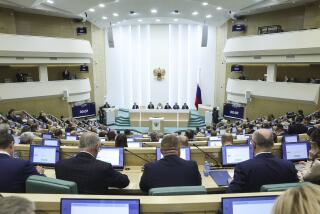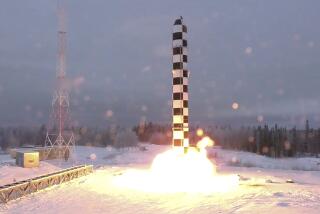U.S. Nuclear Testing
- Share via
On Feb. 3 the United States conducted the first nuclear test of the year. In doing so we not only gave the Soviets the go-ahead for the resumption of their own nuclear testing program, we also in effect told the world that we do not seek an end to horizontal nuclear proliferation or the arms race.
The Soviet Union has refrained from testing nuclear weapons since Aug. 6, 1985, the day it began its nuclear testing moratorium and, not incidentally, the 40th anniversary of the atomic bombing of Hiroshima.
The Reagan Administration initially dismissed the Soviet declaration as propaganda, an insincere bluff not to be taken seriously. It also sought to confuse the public by making the allegedly similar offer of allowing the Soviets to observe U.S. tests.
Observation and discontinuation aren’t exactly synonymous, however, and when the Soviets extended the moratorium at the end of the year, it began to look as though they really were serious. The Administration response was that even if the Soviets were sincere about halting the design and testing of new types of nuclear weapons, such an action would be unverifiable and would also reduce the reliability of the U.S. strategic deterrent.
Again the Administration sought to confuse the issue--this time by associating the difficulties identified with verifying a threshold test ban (prohibiting tests over a threshold, 150 kilotons) with those of verifying a comprehensive test ban or nuclear-testing moratorium. (A negotiated ban on all nuclear testing would be the easier of the two to verify since it would establish verification measures such as on-site inspections and remote monitoring stations.)
Eminent seismologists quickly countered, explaining that with a threshold ban the difficulty lay in determining exactly what the yield of the explosion was (e.g., was it 145 kilotons or 155 kilotons?) but that a comprehensive ban required merely the ability to detect a nuclear explosion. (It’s a little like being hit by a truck. You don’t need to know how fast it was going to know you were hit!)
Although the debate raged, it was for the most part confined to arms control and scientific journals, with much of the public unaware of or indifferent to it. Verification wasn’t the obstruction President Reagan made it out to be, but what about the claim that a ban on testing would erode confidence in deterrence? The simple fact is that it is a lie. Even if the reliability of the weapons does decrease, and this is an extremely generous concession, it decreases not confidence in their function as a deterrent but in their utility as agents of preemption. This is because to deter you need only ensure that a fraction of your arsenal will work as planned--perhaps 400 out of 12,000--but to preempt you need to be certain that all of your weapons operate perfectly, otherwise some of your opponent’s forces may survive to retaliate.
This is only an indirect part of the reason that the Reagan Administration refused to join the moratorium and killed the comprehensive test ban negotiations. Reagan believes the United States can fight and win a nuclear war. The United States is therefore seeking to develop new weapons to increase the range of nuclear options available to it and for application in the supposedly non-nuclear Strategic Defense Initiative. The X-ray laser, a projected energy weapon utilizing nuclear explosions is the best-known example. However, according to scientists in a position to know, (for example, the former deputy scientific director of the Defense Nuclear Agency, Theodore B. Taylor) there are literally hundreds of other possibilities.
It all comes down to this: President Reagan and his advisers were presented with a policy question that would, depending upon their decision, slow or halt the arms race, or allow it to continue unabated. In declining to join the moratorium they have unequivocally chosen the latter option.
DAVID J. TRICKETT
Irvine
More to Read
Sign up for Essential California
The most important California stories and recommendations in your inbox every morning.
You may occasionally receive promotional content from the Los Angeles Times.










